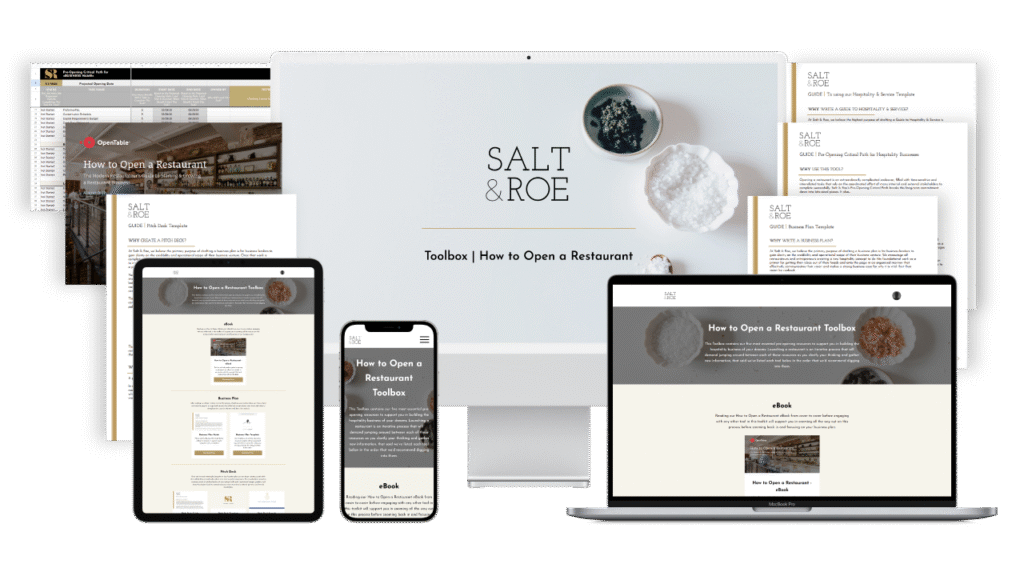Most people start their restaurant business full of excitement. They come with a dream space on a vision board, a menu in mind, and maybe a more attractive and personalized name. After some time when they hit reality, their confidence gets loose. Many factors, like Budgets, staff training, marketing plans, permits, and supplier negotiations, make them feel overwhelmed and lost.
Statistics show many restaurant owners failed because of poor planning or failure to scale systems. It is often seen that the lack of guidance and structure leads the restaurant owners towards failure. Without a solid roadmap, even the best strategy can fall apart before the start.
To avoid those pitfalls, having a well-defined toolkit is a necessity. That’s where Salt & Roe’s How to Open a Restaurant toolkit steps in. It is a complete and comprehensive startup guide that changes confusing ideas into clarity. With proven systems, one-on-one coaching support, and ready-to-use templates, you will learn how to start without stress.
In this article, we will discuss everything included in this toolkit. We will show how it helps you fund, plan, and open your restaurant confidently without the guesswork or stress.

- How to Open a Restaurant eBook
The ebook is your step-by-step guide to opening a restaurant from the start. It gives you clarity of what to expect, what to avoid, and how to make plans at the right pace.
It is like getting a behind-the-scenes look at how successful restaurants are built from vision to opening.
You can download this ebook for free from Salt & Roe so you can get their proven method before investing too much in the full toolkit.
Why this eBook?
- Before you dive into execution, you need a proper roadmap. The eBook helps you see all phases, like vision, planning, funding, operations, and launch.
- Many new owners have some basic steps like permits, design spaces, and staffing timelines. This guide surfaces those.
- By seeing the full picture in advance, you reduce overwhelm and can take action with more certainty.
How to use it?
- Start with reading the eBook once from beginning to end to get the full picture. Then go back to each section as you move through your planning and setup stages.
- Use it like a checklist and mark or highlight the parts you still need to work on.
- Keep it handy or bookmarked so you can refer to it whenever you feel stuck or need guidance.
- Business Plan Bundle
This is a dedicated and hospitality-specific business plan template for restaurants, but not a generic startup plan. It includes prompts for concepts, menu costing, financial forecasts, staffing, and sample plans.
Slat & Roe also provides complete sample plans from real clients so you can see what a perfect plan looks like.
Why does it matter:
- If you intend to raise money from investors, banks, or partners, you will need a polished business plan.
- Writing it forces you to test the model costs, assumptions, and verify whether your ideas can realistically sur
- As pressures come from changing the menu, pivot, and scale faster, you refer back to the original plan to stay aligned.
Tips for implementation:
- Populate the plan early even with rough numbers and update it quarterly as you refine.
- Use conservative assumptions for revenue and aggressive ones for cost sensitivity like labor, overhead, and food waste.
- Share it with mentors for feedback; the structure matters, but clarity of thought is what counts.
- Pitch Deck Toolset
This is a plug-and-play pitch deck template made for restaurant financing and partnership conversations. It typically comes with the design guidelines, sample images, slide structure, and completed examples.
So instead of hiring a designer or building from scratch, this will give you a polished investor-ready deck fast.
Why use the Pitch Deck Toolset?
- A professional and compelling deck helps you stand out and build credibility.
- Turning your restaurant idea, number, and vision into a short 10-20 slide presentation helps you stay focused and clear about what really matters.
- You can use the deck for co-founders, partners, or even staff training to align your team.
Best Practices:
- Customize visuals and narratives to your unique story. Do not use it without adaptation.
- Focus on the number, unit economics, market sizing, funding ask, ROI, and break-even points.
- Rehearse your pitch while showing the deck. Design matters, but storytelling and delivery are equally important.
- Pre-Opening Critical Path Template
This is a detailed timeline and task-sequencing spreadsheet or Gantt-style plan. It walks you through every step from vision to grand opening. Think of it as your master checklist with dates, responsibilities and dependencies.
This template reveals many smaller tasks you might not have considered, like staff uniform, signage permits, point of sale integration, and soft opening logistics.
Why it’s a Game Changer:
- It keeps you on schedule, with no more scrambling the month before opening, and tastes are visible.
- It avoids critical omissions because it is built from past real openings.
- For delegation and accountability, you can assign a timeframe, owner, and status to each task.
Best to use the method:
- Set realistic timelines with buffers like delays.
- Update it weekly, review in our team meetings
- Use color codes to flag items behind schedule.
- Integrate it with your project management tool if you prefer visual boards.
- Guide to Hospitality and Service Template
This is a service standards template that defines how your team should deliver the guest experience. It includes sections like service flow, table turns, greeting protocols, server scripts, complaint handling, and upselling.
Why it’s Critical:
- Consistency and brand promise are profound. Regardless of which staff member serves, the guest should receive a consistent and best experience.
- New hires can be onboarded faster when clear expectations and scripts exist.
- Your service style, whether it’s friendly, detailed, or fast, becomes part of your restaurant’s culture. This helps you define it clearly and make sure everyone follows it.
Tips to customize:
- Use your brand voice, relaxed, casual and formal when writing guest interaction scripts.
- Include examples of tricky situations, like customer complaints, delays, or menu changes. It will show your team how to handle the situations.
- Practice these situations during training instead of just giving staff the written and useless guide.
- After opening, review and update your guide regularly, since real customer feedback can help you make it even better.
- 1 FREE Hour of Business Coaching with Alison and Salt & Roe Team
This is the life coaching session included as part of the package beyond templates and self-paced tools. It gives you personalized time with Alison or another Salt & Roe guide to ask questions, clarify confusing points, and validate your plans.
Why does it add value?
- It provides real guidance. Templates are helpful, but expert eyes can catch things you might miss and share fresh ideas.
- Coaching keeps you motivated, on track, and helps you move past challenges and keep your progress steady and quickly.
- You can share your own business plan or pitch, and get specific advice, not just general tips.
Best Suggestions:
Be prepared and list 2,3 things you want to help with. Like your budget, service plan, or layout.
If you can send your documents before the session, so the coach has time to review them, share them early.
Use the call to confirm your main ideas, not small details.
After the session, pick one or two tasks to complete within a week. So you can put the advice into action.
How These Tools Fit Together.
To get more value, you should use these resources in an organized way.
- Start with the eBook by reading the overview, understanding each phase, and noting any areas. where you need more confidence and clarity.
- Write your business plan by using a template to outline your idea, financial goals, and target market.
- Convert the plans into a pitch deck to make it clear and investor friendly.
- Set your pre-opening timeline template to plan every step from now until opening day. Highlight key tasks that depend on others.
- Make your service guide for convenience. Describe the guest experience you want to offer and how your team will present it.
- Once your drafts are ready, use your coaching hours to meet with Alison or your coach for personalized feedback.
Try to work through this in order to avoid any kind of mistake.
- Additional Tips and Common Mistakes to Avoid
- These templates are already written concisely and are powerful. Use them as they are and then make them small.
- Add some extra time and money to your plan in case things take longer.
- Use a soft launch period to test service guides and plan templates. Your templates should allow for that planning.
- After opening, revisit your service guide templates. Real customer behavior will teach you things no template can.
- Even if not take the coaching call, get peers and restaurants, or mentors to review your material.
Conclusion
Opening a restaurant does not have to feel stressful or confusing. With the right tools, like a clear eBook, pitch deck, business plan, step-by-step timeline, service guide, and expert coaching. You can turn your dreams into a well-defined, successful launch.
The Salt & Roe toolkit brings all these resources together in one easy package. This is designed especially for new restaurant owners.
What next! Start by downloading the free eBook to explore the process. If it feels right for you, get the full toolkit and claim your free coaching hours. So you can move easily from planning to opening day with confidence.








